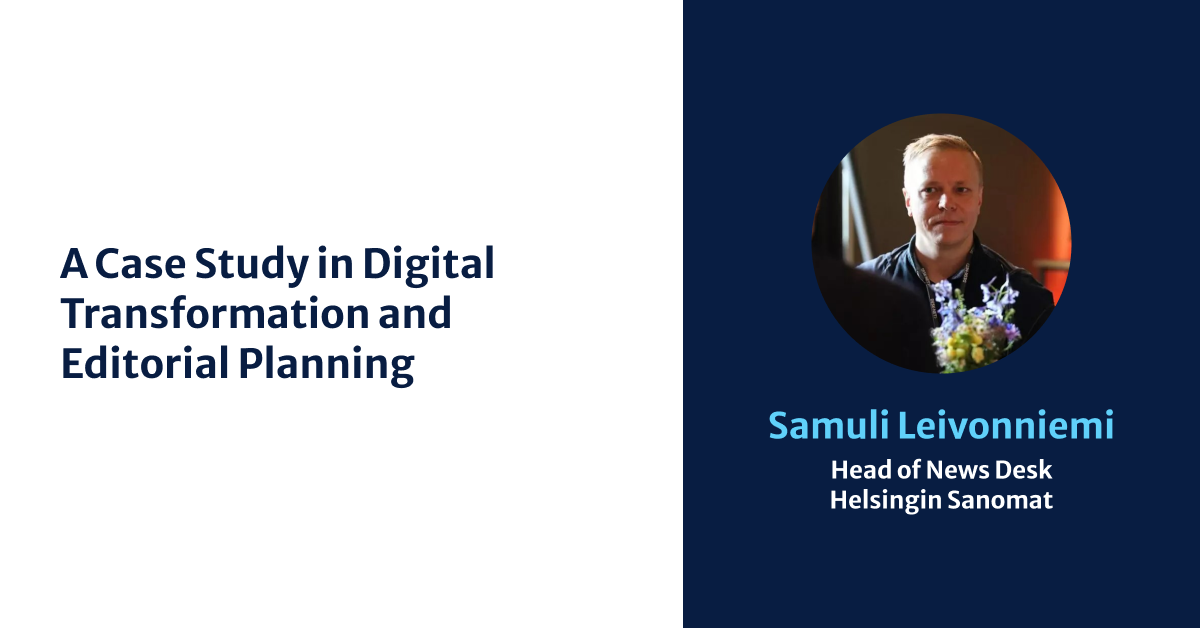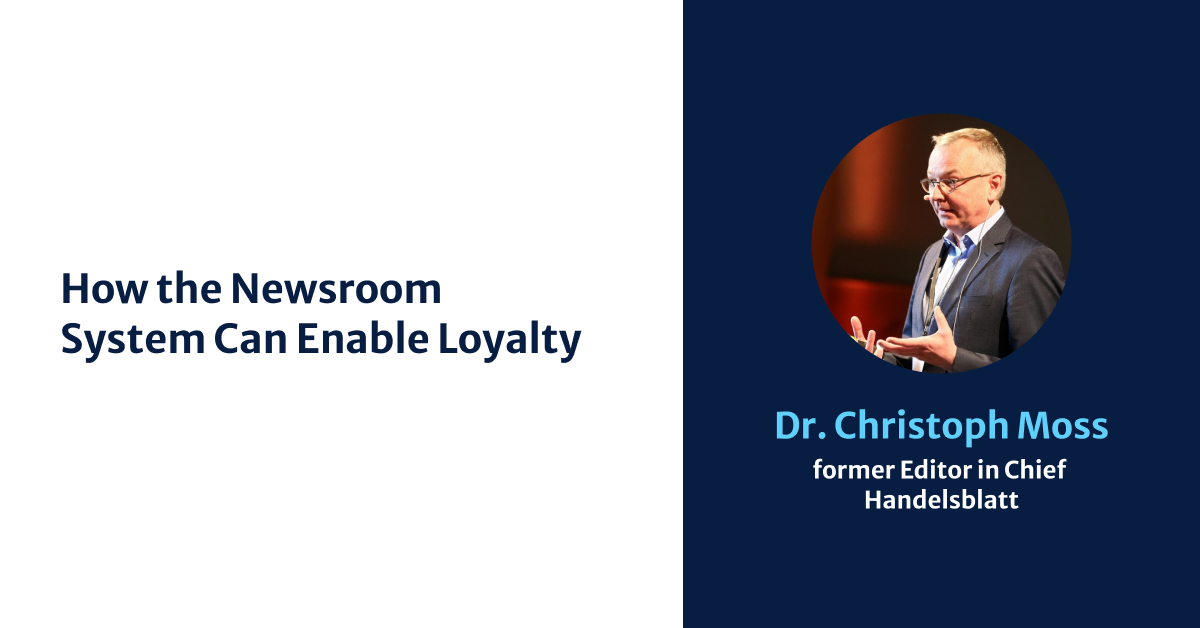Strategies for Digital Loyalty Using Kordiam’s Planning Tools
“This might seem a bit obvious,” Karsten Ellehauge Haag permits himself a wry smile before continuing; “but I’m sure a lot of you working in the newsroom know there is a tension between digital and print.”
A quiet half-laugh ripples around the room at Kordiam Editorial Days 2019 in Hamburg. It is clear the print/digital divide is still very much a subject that newsrooms are grappling with. The theme of Editorial Days 2019 was ‘loyalty,’ and Karsten’s point was that “building digital loyalty requires digital focus.”
As a consultant working on the restructuring of Danish publishing Berlingske Media, Karsten found a company very much struggling with the power of its legacy, and looking at outsourcing and newsroom software improvements as a way of harmonizing and streamlining its assets to better move forward.
Karsten Ellehauge Haag and Berlingske Media
“Berlingske Media had three superbrands: Berlingske, itself one of the world’s oldest newspapers, the tabloid BT, and the national weekly, Weekendavisen. Of these, Berlingske enjoys considerable esteem but is declining as its customers themselves are declining to pay for the paper. Weekendavisen is print-focused, and the group’s website is a major national site but short on digital revenue.”
Previous attempts to reboot the group had yielded small results, but at significant cost, Karsten explained and over time the newsrooms and staff had drifted back to the old ways with one editor talking about the legacy way of working “sneaking back in along every wall and ceiling.”
Falling Back on the Old Process: Cultural Drift at Berlingske
Karsten attributes this to cultural drift. “Cultural Drift in organizations is a concept described by Edgar H. Schein addressing the mismatch between what you say you want to change and what actually happens in the organization.”
In this representation, the outer level - the artifacts - are the symbols of an old process. So, for example, at Berlingske, they keep the old printing press in reception. However, these symbols are part of the company’s make-up. Then you have espoused values, the stated strategy. Thirdly in the inner circle, you have the underlying assumptions about what we feel or believe and the way things are actually around here.”
The crucial part of this Matryoshka doll of identity is that the core is implicit but goes entirely unsaid. It is all too easy to address the surrounding layers without changing anything about the assumptions or feelings of those involved. Alternatively, put more simply; “you may be implementing stuff, but it doesn’t mean the staff will follow suit.”
Previous attempts at change had met with massive resistance from the journalists and industrial action. “Employees left and their knowledge left with them.”
Those previous initiatives had included outsourcing, once seen as the answer to more streamlined companies of all kinds. However, as Karsten points out, “If you outsource things that does not mean you are now free of them. You have to put resources into nursing that outsourcing and communicating with it, and that is crucial to performance.”
Outsourcing, Cost-Saving, and Quality
In the round of restructuring that Karsten worked, one of the aims was to reverse the existing split of resources. Before restructuring, the allocation of resources between print and digital was 70/30. The idea was to reverse that.
“We realized that to succeed, we needed a lot of workshops to get the outsourcing [printer] partner up to speed on the quality and approach. This is a very high-quality product; it is Berlingske after all. Even with the workshops initially performance, speed, and quality all dipped as both sides learned, but today [one year on] the quality and speed are back up again.”
What stands out here is that despite the financial pressure on any company in the move to digital, the Berlingske restructuring elected to focus on quality, not on cost-saving. “Oh, there were some cost savings, though that was not the main focus of the project.”
Newsroom Software: Key for Digital Growth
Arguably the most significant cultural shift of the new approach came down to the digital tools used in the publishing, and more specifically, the dynamics and direction of the workflow.
“The plan was for content planning to be done in the newsroom with the external partner doing the layout but using the paper’s CMS. Any additional text editing that was required was to be done in the newsroom.”
So the newsroom created content and retained the rights over final approval but no longer managed the layout. Furthermore, all content was to be created in the digital CMS where previously it had been split between a digital and a print CMS. To seal the shift access to the print CMS was revoked generally and the previous two-way integration between the print and digital CMS was changed to one way only; from digital to print making it a de facto digital-first operation.
“The way of working in editorial planning was changed. The concept of prime time was brought in with four-time slots a day and different KPIs for each. This had existed before, but it was revitalized and emphasized.”
The old print CMS was from Saxo, and on the digital side, Berlingske uses Drupal Bond. As a planning tool across the company, they chose Kordiam with the accompanying benefits of a shared planning tool and the visibility over copy flow that this brought with it. “The result was significantly improved planning and overview of the prime time flow.”
Growth, Revenue, and Results
“So, what happened?” Karsten reports that; “the entire editorial staff has become more disciplined in planning and in the sharing of plans with more information at hand and more knowledge. BT has seen 60 percent growth in monthly page views, and way outstripped its competitors in the number of visitors from mobile devices with a 25 percent growth in mobile. Berlingske saw nearly 90 percent growth in monthly page views and 80 percent growth in mobile. Also, for the first time, digital revenue has outstripped print.”
Startling stuff and it’s tempting to stop there with those glowing figures. One of the most impressive aspects of Karsten’s presentation, however, was that he was frank enough not to skip over the difficulties on the way.
“Were there challenges? Oh, yes, there were. Habits are hard to change.”
Asked about why the decision was made to outsource print root and branch with all that implied for cultural change he answered that previous attempts to make print a separate division of the same company had failed and that only by removing every connection with print were these results possible.
In terms of the human cost, he noted that the print team was of course laid off, and while they were offered jobs in the new company structure, they mostly didn’t choose to take them. The results speak for themselves, but anyone looking to manage change should be aware that countering the cultural drift and building a new culture of digital loyalty can bring with it certain cultural collateral damage.

